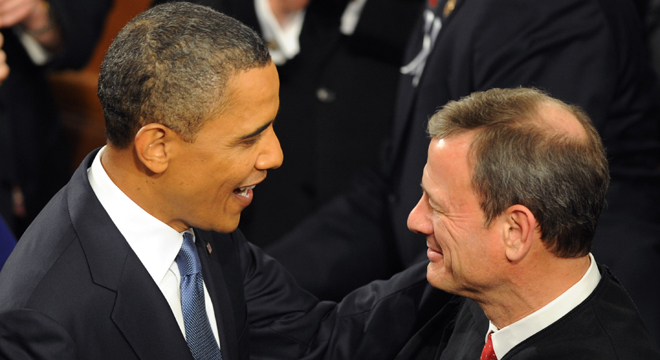Within just a few hours of the Supreme Court handing down its decision last Thursday in the health care reform case, some legal commentators were wondering out loud if Chief Justice John Roberts had flipped positions during deliberations. Teasing out tea leaves from the text of the dissent written by the court’s four remaining conservative justices, court watchers from Paul Campos to David Bernstein speculated that Roberts had originally been aligned with his conservative brethren before switching sides and writing the majority opinion.
It was the usual post-decision parlor game among those who closely follow the court, which remains the least transparent of the three branches of the federal government and whose every utterance, protocol, and even mundane action is highly scrutinized.
But on Sunday CBS legal correspondent Jan Crawford, who has covered the court for years, upped the ante with a report that Roberts initially aligned with the other four conservatives against the individual mandate but at some point switched his vote. Crawford’s report moved the story from parlor game to hot news, relying on two anonymous sources to provide details that would seem to be known only to the justices and their law clerks.
Already feeling betrayed by Roberts’ joining with the liberal bloc on the court to uphold Obamacare — and suspicious of Roberts’ motives — some conservatives seized on the Crawford report as evidence that they didn’t lose the case on the legal merits but because of external considerations that swayed Roberts away from their side.
Here are the top five theories emerging from conservative circles for why John Roberts stabbed their movement in the back:

1) John Roberts caved to the left-wing media
“The bottom line, if Jan Crawford is right, is that conservative justices can be blackmailed by left-wing editorialists. It’s not a pretty picture,” wrote Avik Roy at National Review Online.
“[I]f Roberts goal was to make the liberal commentariat happy, he succeeded with flying colors,” wrote Conn Carroll at the Washington Examiner, dubbing him “Chief Justice John Souter.”
Conservative blogger Erick Erickson, troubled by this possibility, tweeted, “Maybe Lamar Smith and the House Judiciary Committee need to investigate whether political pressure changed Roberts’s mind.”

2) Sen. Patrick Leahy had a mole in the court
At the conservative legal blog Volokh Conspiracy, D.C. lawyer and former senior Bush administration official Stewart Baker speculates that Senate Judiciary Committee Chairman Patrick Leahy (D-VT) may have been tipped off by an inside source ahead of his speech pressuring Roberts not to risk the court’s reputation by overturning the law.
“Now, though, CBS News tells us that the Chief Justice was the defenders’ only hope for a fifth vote — and one that started looking ‘gettable’ right around the time of Senator Leahy’s remarks,” wrote Baker. “Suddenly, the Senator’s remarks look a lot less foolhardy. In fact, they look like a miraculously prescient and well-timed gamble.”
“So well-timed and prescient a gamble that I can’t help wondering whether it was a gamble at all,” he continued.

3) Roberts was cowed by President Obama’s 2010 State of the Union
“Well, It Worked, Didn’t It?” wrote Michael Walsh at National Review Online. “President Obama’s public humiliation of the Supreme Court, that is.”
Walsh was referring to Obama’s criticism of the court’s Citizens United decision in his 2010 State of the Union address. He wondered if “Roberts did make his ‘switch in time’ pusillanimously, to avoid another Obama tongue-lashing.”
“Until the Right understands that the Left cedes us … no legitimacy at all it will continue to be surprised by weak men like John Roberts, who allowed a rogue president to publicly browbeat him and the institution he heads — and then, when he had a chance to pay him back, turned tail and ran,” wrote Walsh.

4) Roberts wanted love from the D.C. establishment
“Justice Roberts wanted to be loved by the Washington establishment,” said Donald Trump on Fox News. “And by the way, he is now. The way they’re talking about him, it’s unbelievable. So he is a beloved man to the liberals and to the Washington establishment and to others, and despised by the people who really counted. In a sense, he was extremely disloyal.”
“He did it because he wanted to be loved by the establishment, and I think it’s as simple as that.”

5) Republicans stink at picking Supreme Court justices
“Why are Republicans so awful at picking Supreme Court justices?” mused former Bush speechwriter Marc Thiessen. “Democrats have been virtually flawless in appointing reliable liberals to the court. Yet Republicans, more often than not, appoint justices who vote with the other side on critical decisions.”
Thiessen mentioned Republican-appointed Justices Sandra Day O’Connor, David Souter Anthony Kennedy, and now John Roberts, as unreliable conservatives. “So Democrats are four-for-four — a perfect record,” he wrote. “Republicans are not even batting .500.”
At NRO, Avik Roy offered a solution: “Perhaps, the next time a Republican president nominates a Supreme Court justice, he should make the candidate swear to never pick up a newspaper.”
—
The upshot of these counter-narratives for why Roberts decided the case the way he did has the effect of delegitimizing the court’s decision. Proponents of the law didn’t win on the merits, the thinking goes. They won because of an unfair advantage: external pressure that trumped the legal considerations that should have dictated the outcome of the case. It’s an early indication that the right’s reaction to losing may be to tear down the court and their one-time legal savior John Roberts.










